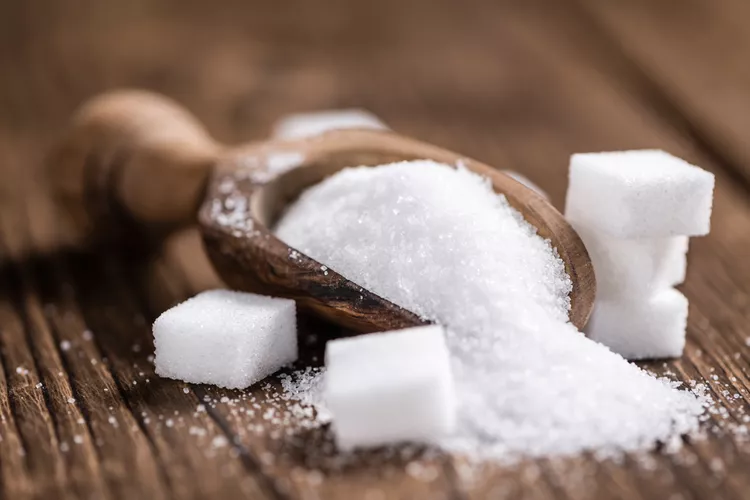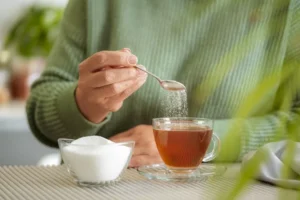
Honey, fruits, and milk are among the foods that naturally contain sugars. Sugar cane and sugar beets are used to make table sugar in an industrial setting. One
One kind of sweetener that has fewer calories than sugar is sugar alcohol. They are frequently included in foods without added sugar.
Excessive use of sugar and Sugar Alcohols might have negative health effects.
What Is Sugar?
Carbohydrates are sugars. They are used to ferment, preserve, and add sweetness to foods and beverages. Additionally, medications and other medicinal goods contain sugars. One
Monosaccharides and disaccharides are the two types of sugars.
Monosaccharides include fructose, galactose, and glucose. Fruits include glucose and fructose, whereas milk has galactose.
Two monosaccharides are present in disaccharides. Lactose contains galactose and glucose, whereas sucrose (table sugar) contains fructose and glucose.
Monosaccharides and disaccharides can both be found in naturally occurring or artificially manufactured added sugars. About 75% of honey is made up of monosaccharides, and 15% is made up of disaccharides.
What Is Sugar Alcohol?
Fruits and some vegetables naturally contain trace levels of sugar alcohols. In order to produce a sweetener, they are also taken out of these natural sources and hydrogenated. mytechspotsnews
Because of their chemical makeup, sugar alcohols are referred to as alcohols. Ethanol, which is present in alcoholic beverages, is absent from them. There are seven types of sugar alcohols:
- Xylitol (as sweet as table sugar)
- Erythritol
- Maltitol
- Sorbitol
- Isomalt
- Lactitol
- Mannitol
Sugar alcohols are frequently employed as sweeteners in diet, sugar-free, and diabetes-friendly goods. Additionally, they are employed as thickeners, emulsifiers, bulking agents, anticaking agents, texture enhancers, and flavor enhancers.
Additionally, mouthwashes, chewable vitamins, and lozenges are among the dental and pharmaceutical items that include sugar alcohols.
Differences Between Sugar and Sugar Alcohols:
Despite their similar applications, sugar and sugar alcohols differ in a number of ways, such as: 3.
Absorption, metabolism, and digestion: Sugar alcohol is only partially absorbed by the intestines. Gases are produced by intestinal bacteria as they digest the majority. Sugar alcohols can draw water into the colon and have laxative effects because of their sluggish absorption, especially when taken in larger dosages.
Calories: One gram of sugar contains four calories, although sugar alcohols release less energy due to poor absorption.
Taste: While some sugar alcohols taste pure and sweet like sugar, others have an unpleasant aftertaste. Additionally, the majority of Sugar Alcohols leave the mouth feeling chilly.
Sweetness: The only substance sweeter than sugar is xylitol. Sugar is sweeter than other sugar alcohols.
Usage: Although sugar is typically used as the default sweetener in most products, sugar alcohols are typically found in diet, sugar-free, or diabetes-friendly products.
Oral health: Because sugar alcohols like sorbitol and xylitol can suppress some germs that cause tooth decay, they are added to dental products.
Similarities Between Sugar and Sugar Alcohols:
There are also parallels between sugar and sugar alcohols, such as:
They come from natural sources: Sugar and sugar alcohols are found in some foods, like fruits, naturally. After that, these materials are removed and prepared for use in a variety of food items. Aspartame and other artificial sweeteners are not naturally present in food.
They can have negative health impacts: When taken in excess, sugar and sugar alcohol can both have negative health effects. Because consuming too much added sugar can lead to weight gain and chronic illnesses like diabetes and heart disease, the Centers for Disease Control and Prevention (CDC) advises consuming no more than 10% of your daily calories from added sugar. 5. When taken in larger quantities, many sugar alcohols can also result in gastrointestinal adverse effects such as diarrhea, bloating, and stomach pain.
Which Is Healthier?
Excessive intake of sugar or sugar alcohols might have negative health effects.
Sugar alcohols may be a good substitute for sugar for diabetics. Choosing meals sweetened with sugar alcohols can help with blood glucose management because they don’t raise blood sugar levels like sugar does.
To ascertain whether Sugar Alcohols are the best choice for diabetics, however, there is insufficient research. To find out if sugar alcohols can also lead to health issues, more research is required. For instance, consuming a lot of artificial sweeteners may increase your chance of
developing diabetes, according to some research.
Because sugar alcohols are less sweet than sugar, they may be consumed in greater quantities and may have negative consequences. Remember that not all sugar-alcohol-containing items are suitable for diabetics because they may still contain significant carbohydrate content.
Risks and Considerations:
Gases produced by gut bacteria that break down sugar alcohols can result in gastrointestinal symptoms such as flatulence, diarrhea, and pain in the abdomen. 36 These negative effects may occur in certain individuals who are particularly susceptible to sugar alcohols.
Additionally, according to some research, adding Sugar Alcohols may raise the risk of cardiovascular illnesses. 10. The few amounts that are naturally present in entire foods, however, are usually well tolerated.
Obesity, weight gain, and chronic diseases like diabetes and heart disease are all associated with eating too much added sugar.
A Quick Review:
One kind of sweetener that is frequently seen in diet, diabetes, and sugar-free goods is sugar alcohol.
Unlike sugar, sugar alcohols do not raise blood glucose levels and offer few calories. It’s crucial to use both sweeteners sparingly, though.










xqvitd